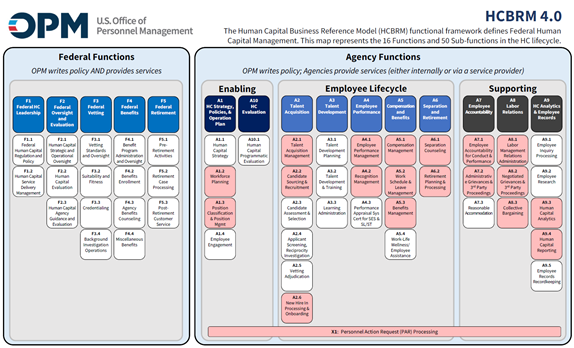Federal Human Capital Business Reference Model
The Federal Human Capital Business Reference Model (HCBRM) defines the end-to-end lifecycle of Federal Government Human Capital Management. The HCBRM was developed by engaging HR policy and industry experts via working groups and reviews. This model is used to assist agency Human Resources (HR) specialists in performing their functions and defines a uniform model for the HR user experience. Many agencies are using the HCBRM as a basis for developing their human capital strategies as well as providing a foundation for Human Resources Information Technology (HRIT) modernization planning.
The HCBRM includes functional categorization and definition, delegated policy oversight, and legal and regulatory matters affiliated with the HR concepts included in the HCBRM. It is composed of 16 functions and 50 sub-functions (18 of which comprise the “employee lifecycle”) that represent all the statutorily required activities the government must perform to establish and manage a competitive and world-class workforce. It contains agency-specific and OPM-specific functional responsibilities.
The HCBRM supports Federal agencies and partners by providing a clear, transparent, and common HCM functional structure that:
- Informs stakeholders using a simplified view of HR operational functions and policy ownership;
- Provides HR practitioners with a quick reference to understand the main functional requirements for their specific area of HR;
- Enables agency leadership with a model to more effectively plan for, deliver, assess, and manage their HR workforce, policy, processes, budget, and service delivery; and
- Outlines the process for significant government-wide HR operations, acquisition, budget formulation, programmatic evaluation, shared services, and data.
Federal HC leaders, HR Practitioners, and partners can use the HCBRM for:
- People: Assess, align, and staff their HC workforce readiness based on the agency-specific HC functions outlined in the HCBRM.
- Policy: Assess an agencies agency’s existing policy structure to evaluate if they address all aspects of the agency-specific HC functions’ requirements.
- Process: Align, assess, and improve processes and procedures for the agency-specific HC functions.
- Service Delivery/ Human Resources Information Technology (HRIT): Align, assess, and modernize HRIT and shared services to support all HC functions.
- Data categorization and reporting: Establish a common and transparent alignment of Governmentwide HR operational, contract, and budget data by aligning, as authorized by law, to the HCBRM coding taxonomy.
- Human Capital Federal Integrated Business Framework (HC-FIBF) Adoption: The HRLOB and MAESC, in collaboration with the CHCOC and the General Services Administration (GSA) Office of Shared Solutions and Performance Improvement (OSSPI), Office of Government-wide Policy, Business Standards Council (BSC), developed baseline Governmentwide HC service standards for all HC functions in the HCBRM for adoption by agencies. The HC-FIBF includes five components:
- Federal Business Lifecycles, functional areas, functions, and activities serve as the basis for a common understanding of what services agencies need and solutions that should be offered.
- Business Capabilities are the outcome-based business needs mapped to Federal government authoritative references, forms, inputs, outputs, and data standards.
- Business Use Cases are a set of agency “stories” that document the key activities, inputs, outputs, and other line of business intersections to describe how the Federal government operates.
- Standard Data Elements identify the minimum data fields required to support the inputs and outputs noted in the use cases and capabilities.
- Service Measures define how the government measures successful delivery of outcomes based on timeliness, efficiency, and accuracy targets.
For more information contact HRLOB@opm.gov.
Download HCBRM 4.0 Definitions
Download CHCO Council Memorandum for HCBRM 4.0 Update




